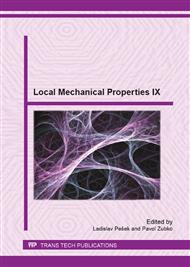p.79
p.83
p.87
p.91
p.96
p.100
p.104
p.108
p.112
Digital Image Correlation Based Method of Crack Growth Rate and Fracture Toughness Measurements on Mini-Samples
Abstract:
Modern materials fabrication methods which utilize severe plastic deformation (SPD) do not often allow to obtain enough volume of material to prepare standardized samples for mechanical tests. Therefore, there is a need for mini-samples testing. Mini-samples tests require special approach in terms of precise strain measurements. Accurate strain measurements may be achieved by means of non-contact optical method, namely Digital Image Correlation (DIC). The aim of this work is to present the methodology and results of mini-samples tests in which displacement fields measurements performed by means of DIC and inverse method were utilized for calculation of stress intensity factors and crack tip position tracking. The influence of the subarea of optical measurements for which calculation were performed on the calculations results has been investigated during tests in SPD processed Al alloys and brittle WC-Co sinters produced by means of impact sintering method.
Info:
Periodical:
Pages:
96-99
Citation:
Online since:
September 2013
Price:
Сopyright:
© 2014 Trans Tech Publications Ltd. All Rights Reserved
Share:
Citation:


